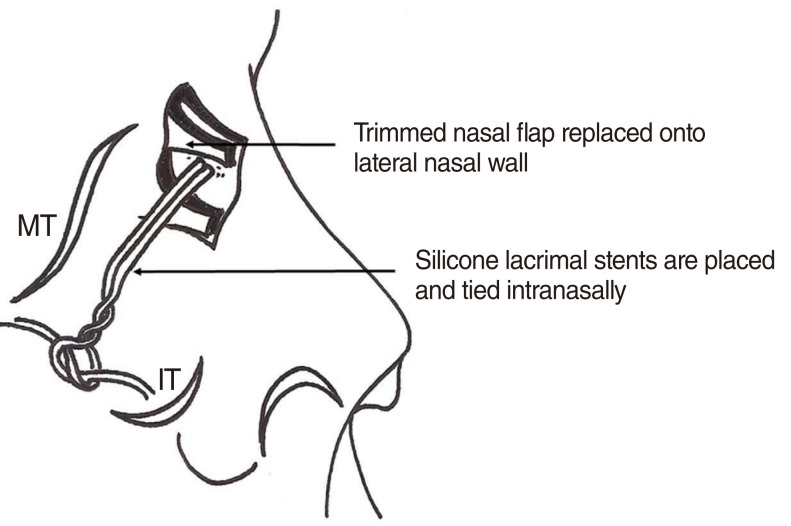Clin Exp Otorhinolaryngol.
2012 Jun;5(2):101-106. 10.3342/ceo.2012.5.2.101.
Surgical Results of Endoscopic Dacryocystorhinostomy and Lacrimal Trephination in Distal or Common Canalicular Obstruction
- Affiliations
-
- 1Department of Otolaryngology-Head and Neck Surgery, Cheonan Hospital, Soonchunhyang University College of Medicine, Cheonan, Korea. bjbaek@schmc.ac.kr
- 2Department of Otolaryngology-Head and Neck Surgery, Korea University Guro Hospital, Seoul, Korea.
- KMID: 2117504
- DOI: http://doi.org/10.3342/ceo.2012.5.2.101
Abstract
OBJECTIVES
To evaluate the surgical outcomes of endoscopic dacryocystorhinostomy followed by canalicular trephination and silicone stenting in patients with distal or common canalicular obstructions.
METHODS
The medical records of 29 patients (31 eyes) from January 2001 to December 2009 who underwent endoscopic dacryocystorhinostomy followed by canalicular trephination and silicone tube insertion for the treatment of distal or common canalicular obstructions were retrospectively reviewed. The level of obstruction was confirmed by intraoperative probing. The outcome of the surgery was categorized as a complete success, partial success, or failure according to the functional and anatomic patency.
RESULTS
The average age of the patients was 52 years. The duration of silicone intubation ranged from 4 to 11 months with an average of 5.7+/-1.6 months. The follow-up period after stent removal ranged from 4 to 15 months with an average of 8.2+/-3.3 months. Complete success was achieved in 25 out of 31 eyes (80.6%), partial success in 4 out of 31 eyes (12.9%), and failure in 2 out of 31 eyes (6.5%).
CONCLUSION
Endoscopic dacryocystorhinostomy followed by canalicular trephination and silicone stent intubation may be safe and considered as an initial treatment of patients with distal or common canalicular obstructions.
Keyword
MeSH Terms
Figure
Cited by 2 articles
-
Efficacy of Intraoperative Mitomycin C Eye Drops during and after Dacryocystorhinostomy for Canalicular Obstruction
Yu-Jin Choi, Seong Jae Kim, Ji Myong Yoo, Seong Wook Seo
J Korean Ophthalmol Soc. 2018;59(10):899-907. doi: 10.3341/jkos.2018.59.10.899.Results of Silicone Tube Intubation in Patients with Common Canalicular Obstruction in Dacryocystography
Hak Jun Lee, Min Joung Lee
J Korean Ophthalmol Soc. 2015;56(12):1821-1825. doi: 10.3341/jkos.2015.56.12.1821.
Reference
-
1. Jones LT. An anatomical approach to problems of the eyelids and lacrimal apparatus. Arch Ophthalmol. 1961; 7. 66(1):111–124. PMID: 13790551.
Article2. Linberg JV, McCormick SA. Primary acquired nasolacrimal duct obstruction: a clinicopathologic report and biopsy technique. Ophthalmology. 1986; 8. 93(8):1055–1063. PMID: 3763155.3. Jones LT. The cure of epiphora due to canalicular disorders, trauma and surgical failures on the lacrimal passages. Trans Am Acad Ophthalmol Otolaryngol. 1962; Jul-Aug. 66:506–524. PMID: 14452301.4. Rosen N, Ashkenazi I, Rosner M. Patient dissatisfaction after functionally successful conjunctivodacryocystorhinostomy with Jones tube. Am J Ophthalmol. 1994; 5. 117(5):636–642. PMID: 8172270.
Article5. Wearne MJ, Beigi B, Davis G, Rose GE. Retrograde intubation dacryocystorhinostomy for proximal and midcanalicular obstruction. Ophthalmology. 1999; 12. 106(12):2325–2328. PMID: 10599666.6. McDonogh M, Meiring JH. Endoscopic transnasal dacryocystorhinostomy. J Laryngol Otol. 1989; 6. 103(6):585–587. PMID: 2769026.
Article7. Sisler HA, Allarakhia L. A new ophthalmic microtrephine. Ophthalmic Surg. 1990; 9. 21(9):656–657. PMID: 2250878.
Article8. Sisler HA, Allarakhia L. New minitrephine makes lacrimal canalicular rehabilitation an office procedure. Ophthal Plast Reconstr Surg. 1990; 6(3):203–206.9. Khoubian JF, Kikkawa DO, Gonnering RS. Trephination and silicone stent intubation for the treatment of canalicular obstruction: effect of the level of obstruction. Ophthal Plast Reconstr Surg. 2006; Jul-Aug. 22(4):248–252.
Article10. Nemet AY, Wilcsek G, Francis IC. Endoscopic dacryocystorhinostomy with adjunctive mitomycin C for canalicular obstruction. Orbit. 2007; 6. 26(2):97–100. PMID: 17613855.
Article11. Keith CG. Intubation of the lacrimal passages. Am J Ophthalmol. 1968; 1. 65(1):70–74. PMID: 5635571.
Article12. Pashby RC, Rathbun JE. Silicone tube intubation of the lacrimal drainage system. Arch Ophthalmol. 1979; 7. 97(7):1318–1322. PMID: 454271.
Article13. Dutton JJ, Holck DE. Holmium laser canaliculoplasty. Ophthal Plast Reconstr Surg. 1996; 9. 12(3):211–217.
Article14. Kuchar A, Novak P, Pieh S, Fink M, Steinkogler FJ. Endoscopic laser recanalisation of presaccal canalicular obstruction. Br J Ophthalmol. 1999; 4. 83(4):443–447. PMID: 10434867.
Article15. Wilhelm KE, Hofer U, Textor HJ, Boker T, Strunk H, Schild HH. Nonsurgical fluoroscopically guided dacryocystoplasty of common canalicular obstructions. Cardiovasc Intervent Radiol. 2000; Jan-Feb. 23(1):1–8. PMID: 10656900.
Article16. Yang SW, Park HY, Kikkawa DO. Ballooning canaliculoplasty after lacrimal trephination in monocanalicular and common canalicular obstruction. Jpn J Ophthalmol. 2008; Nov-Dec. 52(6):444–449. PMID: 19089564.
Article17. Yung MW, Hardman-Lea S. Analysis of the results of surgical endoscopic dacryocystorhinostomy: effect of the level of obstruction. Br J Ophthalmol. 2002; 7. 86(7):792–794. PMID: 12084752.
Article18. Sprekelsen MB, Barberan MT. Endoscopic dacryocystorhinostomy: surgical technique and results. Laryngoscope. 1996; 2. 106(2 Pt 1):187–189. PMID: 8583851.19. Tsirbas A, Wormald PJ. Endonasal dacryocystorhinostomy with mucosal flaps. Am J Ophthalmol. 2003; 1. 135(1):76–83. PMID: 12504701.
Article20. Unlu HH, Toprak B, Aslan A, Guler C. Comparison of surgical outcomes in primary endoscopic dacryocystorhinostomy with and without silicone intubation. Ann Otol Rhinol Laryngol. 2002; 8. 111(8):704–709. PMID: 12184592.
Article21. Camara JG, Bengzon AU, Henson RD. The safety and efficacy of mitomycin C in endonasal endoscopic laser-assisted dacryocystorhinostomy. Ophthal Plast Reconstr Surg. 2000; 3. 16(2):114–118.
Article
- Full Text Links
- Actions
-
Cited
- CITED
-
- Close
- Share
- Similar articles
-
- Canalicular Trephination with Lacrimal Trephine and Endoscopic DCR
- Clinical Outcomes of Endonasal Dacryocystorhinostomy with Canalicular Trephination in Canalicular Obstruction
- Surgical Outcomes of Canalicular Trephination Combined with Endoscopic Dacryocystorhinostomy in Patients with Distal or Common Canalicular Obstruction
- Ballooning Canaliculoplasty and Silicone Tube Intubation after Lacrimal Trephination
- The Effectiveness of Lacrimal Trephination for the Treatment of Canalicular Obstruction


